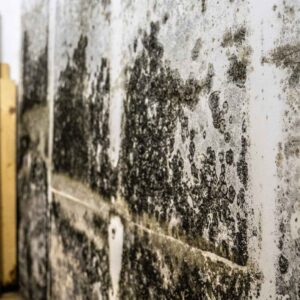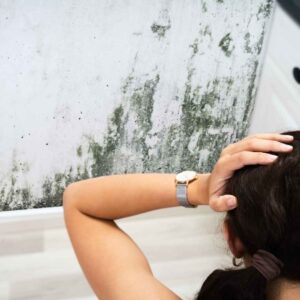Black mold is a buzzword these days. But, is it really what it’s all cracked up to be? Truthfully, black mold is just media hype and is often used as a “scare tactic” by unscrupulous contractors who get homeowners to unwittingly contract them for their “special” services. In this article, we dispel the myths about black mold and discuss how the term was even popularized in the first place.

What Is Black Mold?
Black mold is often touted as this “especially harmful” type of mold. However, there’s nothing unique about black mold. There are thousands of different species of mold (Stachybotrys). Each species carries different toxicity levels and can be expressed by an array of colors–including black. There is no individual type of mold known as “black mold.” Additionally, black-colored molds aren’t necessarily indicative of a more “toxic” form of mold. The term was popularized by the media because it’s easier to say than “Stachybotrys.”
Not everyone is affected in the same way by mold. Some people experience no reaction though others may experience health issues like:
- respiratory problems
- rashes
- red eyes
- congestion
- memory loss
- nose bleeds
- fatigue
- a compromised immune system
- and more…
All molds are a type of fungus that also contain mold spores. Mold spores are their “seeds” or how they reproduce. Many molds also contain mycotoxins, which are generally what people react to. Again, many species of Stachybotrys contain mycotoxins. When people refer to black mold, they’re often referring to a species called Stachybotrys chartarum (S. Chartarum).
Other common types of mold like penicillium aspergillus also cause allergic reactions in some individuals. This is the type of mold that Penicillin antibiotics are derived from.
Why Is Black Mold Considered Dangerous?
Individuals may have severe reactions to mold and many molds tend to appear darker or “black” in color so black molds get particularly demonized. Mold is a normal occurrence in the outdoor environment in Florida and South Georgia. It’s also important to note that it’s normal to have indoor mold present–as long as the count/concentration of mold spores indoors is equal to the outdoor environment.
Problems begin when mold overgrowth occurs due to improperly dried water damage, leaky pipes, leaky roofs, inadequate HVAC systems, poor housekeeping, etc. When mold is left unchecked, prolonged exposure leads to negative health outcomes. Older adults and small children are often most susceptible.
How to Identify Black Mold
The best way to determine if you have a mold problem is to call in a professional mold assessor. They’re often referred to as Indoor Air Quality Assessors, Mold Testers, or Industrial Hygienists. The reason a professional is helpful is that not all mold in your home is visible.

Mold is often present inside walls or places that you can’t see with the naked eye. Mold Assessors use specialized equipment and techniques to find your mold problem and identify the types of mold present. This requires special training, certifications, and experience.
Dealing with Black Mold: Removal & Prevention
The best way to deal with mold is prevention. Mold has 3 requirements for growth:
- Water
- Food (Organic material)
- Warm temperatures
The best way to keep these 3 variables under control in your home or office is by properly maintaining your HVAC system and keeping the thermostat set below 78F. Other ways to prevent mold growth include:
- regular housekeeping
- urgently dealing with water damages
- maintaining your roof to prevent leaks
Should you require mold removal, you can hire a professional mold remediation contractor who will follow your mold assessor’s protocol. The ideal first step if you suspect a mold problem is to call a mold testing firm!
